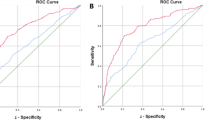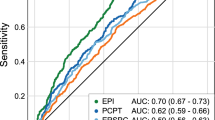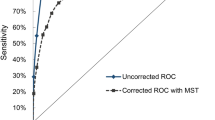Abstract
Estimates for the likelihood of prostate cancer at different levels of per cent free prostate specific antigen (PSA) were derived from experience with consecutive Japanese male patients with intermediate total PSA values who underwent ultrasound-guided biopsies and/or transurethral resection of the prostate. Receiver operating characteristic (ROC) curve analysis showed that in patients with a total PSA of 4.1–10.0 ng/ml, per cent free PSA identified those with prostate cancer better than did total PSA; per cent free PSA also proved superior in the subgroup whose glands appeared benign on palpation. The probabilities of prostate cancer at per cent free PSA values of ≤10.0, >10–15, >15–20, >20–26 and >26% were 58.3, 40.8, 25.3, 14.3 and 7.6%, respectively, when analyzed without regard to findings on palpation. In patients with palpably benign glands, the corresponding values were 55.3, 35.4, 19.6, 9.7, and 4.6%, respectively. These probabilities are lower than those reported in Western countries, probably reflecting both different patterns of practice and racial differences. Race-specific assessment is recommended before applying a clinical test.
This is a preview of subscription content, access via your institution
Access options
Subscribe to this journal
Receive 4 print issues and online access
$259.00 per year
only $64.75 per issue
Buy this article
- Purchase on Springer Link
- Instant access to full article PDF
Prices may be subject to local taxes which are calculated during checkout
Similar content being viewed by others
References
Catalona WJ et al. Use of the percentage of free prostate-specific antigen to enhance differentiation of prostate cancer from benign prostatic disease. A prospective multicenter clinical trial JAMA 1998 279: 1542–1547
Van Cangh PJ et al. Free to total prostate-specific antigen (PSA) ratio is superior to total-PSA in differentiating benign prostate hypertrophy from prostate cancer Prostate 1996 7: (Suppl) 30–34
Egawa S et al. The ratio of free to total serum prostate specific antigen and its use in differential diagnosis of prostate carcinoma in Japan Cancer 1997 79: 90–98
Van Cangh PJ et al. Free to total prostate-specific antigen (PSA) ratio improves the discrimination between prostate cancer and benign prostatic hyperplasia (BPH) in the diagnostic gray zone of 1.8 to 10 ng/ml total PSA Urology 1996 48: 67–70
Egawa S et al. A study on pretreatment nomogram to predict pathological stage and biochemical recurrence after radical prostatectomy for clinically resectable prostate cancer in Japanese men Jpn J Clin Oncol 2001 31: 74–81
Vessella RL et al. Probability of prostate cancer detection based on results of a multicenter study using the AxSYM free PSA and total PSA assays Urology 2000 55: 909–914
Carlson GD, Calvanese CB, Partin AW . An algorithm combining age, total prostate-specific antigen (PSA), and percent free PSA to predict prostate cancer: results on 4298 cases Urology 1998 52: 455–461
Veltri RW, Miller MC . Free/total PSA ratio improves differentiation of benign and malignant disease of the prostate: critical analysis of two different test populations Urology 1999 53: 736–745
Dowell B et al. Development of the Abbott AxSYM free PSA assay: performance characteristics and preliminary clinical evaluation Anticancer Res 1997 17: 3037–3038
Egawa S et al. Prospective evaluation of prostate cancer detection by prostate specific antigen-related cancer detection by prostate specific antigen-related parameters: comparison in serum and plasma samples J Urol (in press)
Egawa S et al. Results of transrectal ultrasound-guided biopsies and clinical significance of Japanese prostate cancer. Jpn J Clin Oncol 1998 28: 666–672
Okihara K et al. Comparative analysis of complexed PSA, free PSA and their ratio in detecting prostate cancer J Urol 2001 165A: 99
Brawer MK et al. Measurement of complexed PSA improves specificity for early detection of prostate cancer Urology 1998 52: 372–378
Maeda H et al. Complexed prostate-specific antigen and its volume indexes in the detection of prostate cancer Urology 1999 54: 225–228
Kikuchi E et al. Prostate specific antigen adjusted for transition zone volume. The most powerful method for detecting prostate carcinoma Cancer 2000 89: 842–849
Stamey TA, Yemoto CE . Examination of the 3 molecular forms of serum prostate specific antigen for distinguishing negative from positive biopsy: relationship to transition zone volume J Urol 2000 163: 119–126
Babaian RJ et al. Performance of a neural network in detecting prostate cancer in the prostate-specific antigen reflex range of 2.5 to 4.0 ng/ml Urology 2000 56: 1000–1006
Acknowledgements
We thank WA Thomasson, PhD, for expert editorial assistance. This work was supported in part by a Grant from the Ministry of Health and Welfare of Japan (7-42) and Foundation for Promotion of Cancer Research in Japan.
Author information
Authors and Affiliations
Corresponding author
Rights and permissions
About this article
Cite this article
Egawa, S., Suyama, K., Takashima, R. et al. Probability of prostate cancer at various levels of per cent free prostate specific antigen in Japanese men with total PSA of 4.1-10.0 ng/ml. Prostate Cancer Prostatic Dis 5, 115–118 (2002). https://doi.org/10.1038/sj.pcan.4500562
Received:
Revised:
Accepted:
Published:
Issue Date:
DOI: https://doi.org/10.1038/sj.pcan.4500562
Keywords
This article is cited by
-
Stromal–epithelial measurements of prostate cancer in native Japanese and Japanese-American men
Prostate Cancer and Prostatic Diseases (2004)



